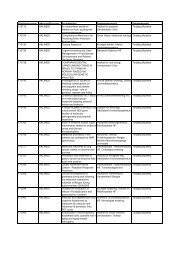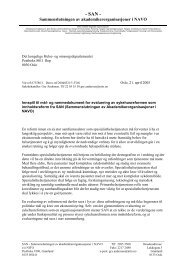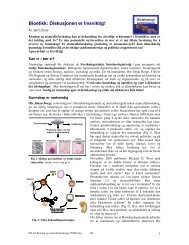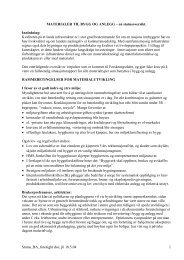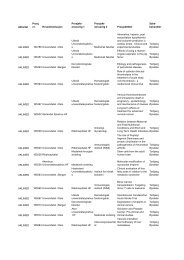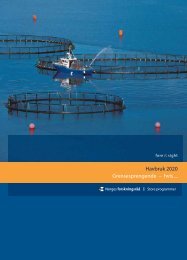A Revolution in R&D
A Revolution in R&D
A Revolution in R&D
You also want an ePaper? Increase the reach of your titles
YUMPU automatically turns print PDFs into web optimized ePapers that Google loves.
still a scientifically risky endeavor. As they construct<br />
their customized portfolio of bets, they will have to<br />
keep review<strong>in</strong>g not just their <strong>in</strong>ternal capabilities but<br />
also the degree of risk they are prepared to accept.<br />
Putt<strong>in</strong>g Disease Genetics <strong>in</strong>to Operation<br />
If companies do opt to participate <strong>in</strong> disease genetics,<br />
they may still choose to ma<strong>in</strong>ta<strong>in</strong> some distance<br />
by outsourc<strong>in</strong>g the activity or licens<strong>in</strong>g <strong>in</strong> the<br />
results. Those that decide to launch a major disease<br />
genetics program <strong>in</strong>-house will confront a number<br />
of significant challenges as they put the program<br />
<strong>in</strong>to operation.<br />
Take the problem of obta<strong>in</strong><strong>in</strong>g the required samples,<br />
for <strong>in</strong>stance. From whom should samples be<br />
collected? And how are samples to be stored? The<br />
use of human tissue raises ethical considerations as<br />
well. What constitutes consent? How can privacy be<br />
protected? Who “owns” the tissue material? And<br />
who should profit from it? (Several companies,<br />
such as Genomics Collaborative and the not-forprofit<br />
First Genetic Trust, are emerg<strong>in</strong>g to address<br />
these conundrums.)<br />
And, of course, there are major organizational<br />
questions. What are the implications for human<br />
resources and labor relations? For big pharmaceutical<br />
companies, new capabilities will be demanded,<br />
and new skills will have to be acquired—statistical<br />
geneticists, for <strong>in</strong>stance, and experts on pathway<br />
genetic studies. And other capabilities may suddenly<br />
be less <strong>in</strong> demand—perhaps even obsolete.<br />
We will discuss implementation issues such as these<br />
<strong>in</strong> more detail <strong>in</strong> the f<strong>in</strong>al chapter of this report.<br />
Pharmacogenetics<br />
Just as some genetic variations among <strong>in</strong>dividuals<br />
may <strong>in</strong>fluence their susceptibility to diseases, so<br />
others may <strong>in</strong>fluence their responsiveness to drug<br />
treatments for those diseases. It is the goal of pharmacogenetics<br />
to seek out and characterize some of<br />
these latter variations.<br />
The sav<strong>in</strong>gs that pharmaceutical companies might<br />
hope to harvest are considerable, though noth<strong>in</strong>g<br />
like as high as those that disease genetics stands to<br />
achieve <strong>in</strong> ideal circumstances.<br />
The Potential<br />
The impact of pharmacogenetics on R&D productivity<br />
will derive from the <strong>in</strong>creased flexibility it<br />
<strong>in</strong>troduces <strong>in</strong>to cl<strong>in</strong>ical development. Currently,<br />
drug-development policy is dom<strong>in</strong>ated by a b<strong>in</strong>ary<br />
scenario <strong>in</strong> its later stages: either shepherd a compound<br />
through its cl<strong>in</strong>ical trials and out to market,<br />
or abandon it as unmarketable if it stumbles <strong>in</strong> the<br />
trials. Pharmacogenetics provides a more nuanced<br />
scenario, with an expanded range of possible outcomes,<br />
by allow<strong>in</strong>g the exclusion of patients genetically<br />
predisposed to respond poorly to the drug.<br />
Two particular benefits emerge: “standard” cl<strong>in</strong>ical<br />
trials can now be streaml<strong>in</strong>ed; and “fail<strong>in</strong>g” compounds<br />
can now be salvaged. (See Exhibit 7.)<br />
The streaml<strong>in</strong><strong>in</strong>g of trials would apply only to compounds<br />
dest<strong>in</strong>ed to proceed successfully through<br />
the cl<strong>in</strong>ical trial process anyway. That path can now<br />
be made smoother. The trials can be designed more<br />
subtly. They can be smaller and quicker than<br />
before, now that it is possible to preselect promis<strong>in</strong>g<br />
patients—that is, patients whose genetic<br />
makeup is likely to maximize the drug’s efficacy<br />
and m<strong>in</strong>imize its side effects. So, patients lack<strong>in</strong>g<br />
the drug-susceptible variation of the target gene<br />
EXHIBIT 7<br />
PHARMACOGENETICS EXPANDS DEVELOPMENT CHOICES<br />
Proportion of patients show<strong>in</strong>g<br />
poor or no response<br />
High<br />
Low<br />
SOURCE: BCG analysis.<br />
Current options<br />
Abandon drug<br />
before market<br />
Cont<strong>in</strong>ue cl<strong>in</strong>ical<br />
trials to market<br />
Options available with<br />
pharmacogenetics<br />
Cont<strong>in</strong>ue trials safely by<br />
exclud<strong>in</strong>g at-risk patients<br />
Optimize cl<strong>in</strong>ical trials,<br />
mak<strong>in</strong>g them<br />
smaller and shorter<br />
33



